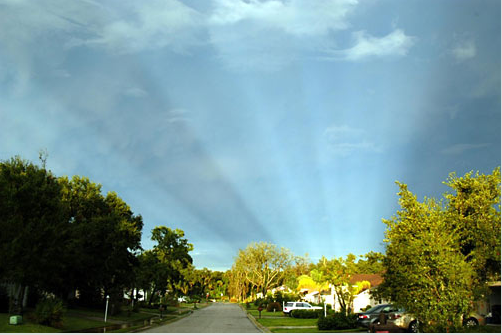Anti-crepuscular rays
Anti-Crepuscular Rays: A Phenomenon of Light and Shadows
Have you ever witnessed a breathtaking natural phenomenon in the sky that left you in awe? One such captivating sight is the occurrence of anti-crepuscular rays. Similar to their more well-known counterpart, crepuscular rays, these rays of light add a touch of magic to the sky during sunrise or sunset. While crepuscular rays are visible in the direction of the setting or rising sun, anti-crepuscular rays appear in the opposite direction. In this article, we will explore the fascinating world of anti-crepuscular rays and delve into the science behind this mesmerizing atmospheric optics phenomenon.
What are Anti-Crepuscular Rays?
Anti-crepuscular rays, also known as antisolar or anticrepuscular rays, are a captivating display of light and shadows that occur when sunlight is scattered by dust, water droplets, or other particles in the atmosphere. These rays appear to converge towards a point on the horizon opposite to the sun, creating a visually stunning effect. Just like crepuscular rays, anti-crepuscular rays are not physically present but are an optical illusion caused by the interaction of sunlight with atmospheric particles.
The Science Behind Anti-Crepuscular Rays
To understand the science behind anti-crepuscular rays, we must first comprehend how sunlight interacts with the atmosphere. When the sun is low on the horizon during sunrise or sunset, its rays have to pass through a greater thickness of the Earth's atmosphere compared to when it is directly overhead. This increased path length causes the sunlight to scatter more, resulting in a diffusion of light across the sky.
As sunlight scatters and interacts with atmospheric particles, it creates a pattern of alternating bright and dark bands. These bands form the distinct rays that appear to converge towards a point on the horizon opposite to the sun. The convergence point is an optical illusion, similar to how train tracks appear to meet at a vanishing point in the distance. The rays of light, although appearing to originate from a single point, are actually parallel and only seem to converge due to the perspective of the observer.
Factors Influencing Anti-Crepuscular Rays
Several factors can influence the visibility and appearance of anti-crepuscular rays:
-
Atmospheric Conditions: The presence of dust, water droplets, or other particles in the atmosphere is crucial for the scattering of sunlight and the formation of anti-crepuscular rays. These particles act as tiny mirrors, reflecting and redirecting sunlight to create the stunning display.
-
Sun's Position: Anti-crepuscular rays are most commonly observed during sunrise or sunset when the sun is low on the horizon. The angle of the sun's rays interacting with the atmosphere plays a significant role in the formation and visibility of these rays.
-
Geographical Location: The position and orientation of an observer relative to the sun and atmospheric conditions can affect the appearance of anti-crepuscular rays. Observers located at different latitudes or longitudes may witness varying angles and intensities of these rays.
Capturing the Beauty of Anti-Crepuscular Rays
If you find yourself fortunate enough to witness anti-crepuscular rays, it is a sight worth capturing. To preserve the beauty of this atmospheric phenomenon, consider the following tips:
-
Use a camera or smartphone with a wide-angle lens to capture a broader view of the sky and encompass the full extent of the rays.
-
Experiment with different exposure settings to capture the contrast between the bright rays and the darker regions of the sky accurately.
-
Look for interesting foreground elements such as trees, buildings, or mountains to add depth and perspective to your photographs.
-
Consider using a tripod to ensure stability and reduce camera shake, especially when capturing longer exposure shots.
Conclusion
Anti-crepuscular rays are a captivating and enchanting display of light and shadows in the sky. As the sun casts its golden hues during sunrise or sunset, these rays add an ethereal touch to the opposite horizon. Understanding the science behind this optical illusion allows us to appreciate the intricate interplay between sunlight and atmospheric particles. So, the next time you find yourself basking in the beauty of a breathtaking sunset, remember to cast your gaze towards the opposite direction, for you might just witness the awe-inspiring phenomenon of anti-crepuscular rays.

More exceptionally bright rays. The setting sun was 3º high and still shining on the trees and houses when Jonathan Sabin saw these rays in the east at Ellenton Florida, August 2003.
�Jonathan Sabin, shown with permission.
Note: this article has been automatically converted from the old site and may not appear as intended. You can find the original article here.
Reference Atmospheric Optics
If you use any of the definitions, information, or data presented on Atmospheric Optics, please copy the link or reference below to properly credit us as the reference source. Thank you!
-
<a href="https://atoptics.co.uk/blog/anti-crepuscular-rays-10/">Anti-crepuscular rays</a>
-
"Anti-crepuscular rays". Atmospheric Optics. Accessed on April 20, 2024. https://atoptics.co.uk/blog/anti-crepuscular-rays-10/.
-
"Anti-crepuscular rays". Atmospheric Optics, https://atoptics.co.uk/blog/anti-crepuscular-rays-10/. Accessed 20 April, 2024
-
Anti-crepuscular rays. Atmospheric Optics. Retrieved from https://atoptics.co.uk/blog/anti-crepuscular-rays-10/.